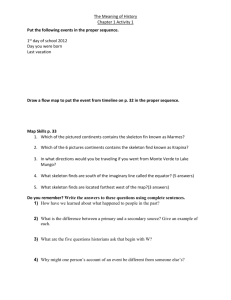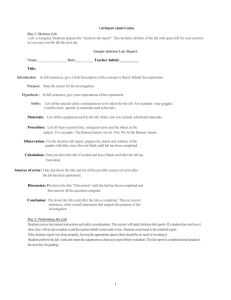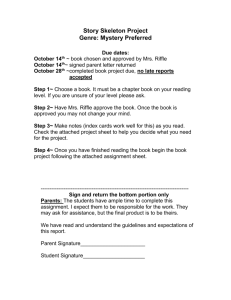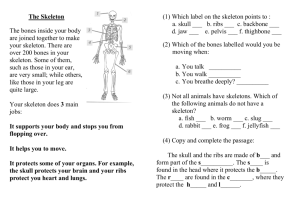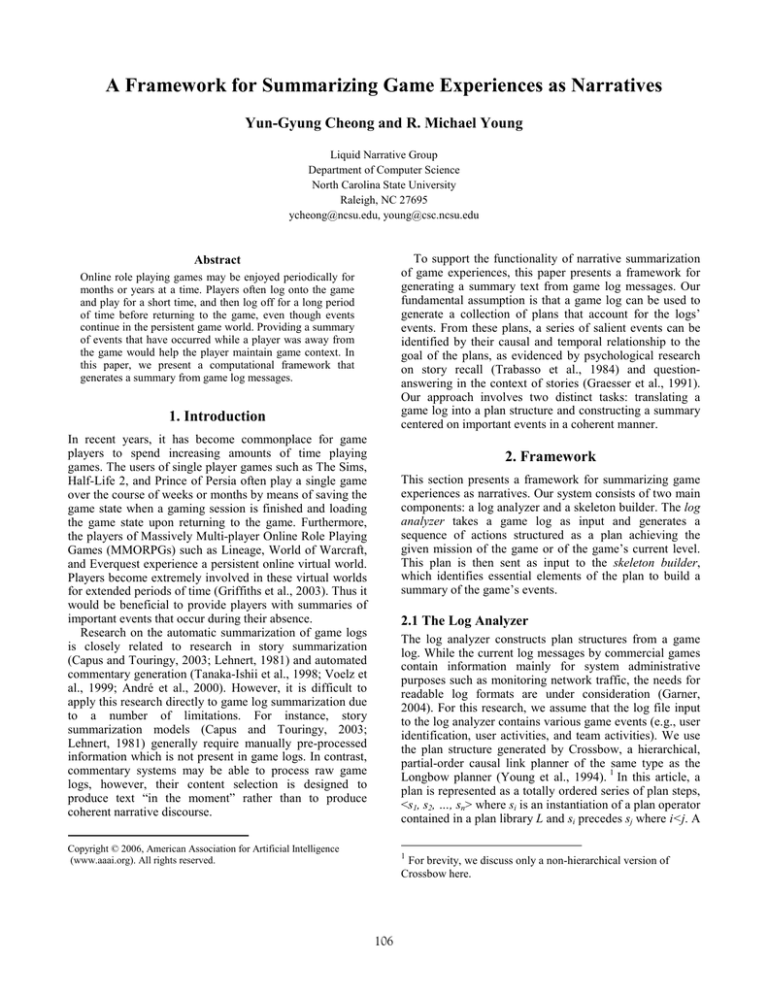
A Framework for Summarizing Game Experiences as Narratives
Yun-Gyung Cheong and R. Michael Young
Liquid Narrative Group
Department of Computer Science
North Carolina State University
Raleigh, NC 27695
ycheong@ncsu.edu, young@csc.ncsu.edu
To support the functionality of narrative summarization
of game experiences, this paper presents a framework for
generating a summary text from game log messages. Our
fundamental assumption is that a game log can be used to
generate a collection of plans that account for the logs’
events. From these plans, a series of salient events can be
identified by their causal and temporal relationship to the
goal of the plans, as evidenced by psychological research
on story recall (Trabasso et al., 1984) and questionanswering in the context of stories (Graesser et al., 1991).
Our approach involves two distinct tasks: translating a
game log into a plan structure and constructing a summary
centered on important events in a coherent manner.
Abstract
Online role playing games may be enjoyed periodically for
months or years at a time. Players often log onto the game
and play for a short time, and then log off for a long period
of time before returning to the game, even though events
continue in the persistent game world. Providing a summary
of events that have occurred while a player was away from
the game would help the player maintain game context. In
this paper, we present a computational framework that
generates a summary from game log messages.
1. Introduction
In recent years, it has become commonplace for game
players to spend increasing amounts of time playing
games. The users of single player games such as The Sims,
Half-Life 2, and Prince of Persia often play a single game
over the course of weeks or months by means of saving the
game state when a gaming session is finished and loading
the game state upon returning to the game. Furthermore,
the players of Massively Multi-player Online Role Playing
Games (MMORPGs) such as Lineage, World of Warcraft,
and Everquest experience a persistent online virtual world.
Players become extremely involved in these virtual worlds
for extended periods of time (Griffiths et al., 2003). Thus it
would be beneficial to provide players with summaries of
important events that occur during their absence.
Research on the automatic summarization of game logs
is closely related to research in story summarization
(Capus and Touringy, 2003; Lehnert, 1981) and automated
commentary generation (Tanaka-Ishii et al., 1998; Voelz et
al., 1999; André et al., 2000). However, it is difficult to
apply this research directly to game log summarization due
to a number of limitations. For instance, story
summarization models (Capus and Touringy, 2003;
Lehnert, 1981) generally require manually pre-processed
information which is not present in game logs. In contrast,
commentary systems may be able to process raw game
logs, however, their content selection is designed to
produce text “in the moment” rather than to produce
coherent narrative discourse.
2. Framework
This section presents a framework for summarizing game
experiences as narratives. Our system consists of two main
components: a log analyzer and a skeleton builder. The log
analyzer takes a game log as input and generates a
sequence of actions structured as a plan achieving the
given mission of the game or of the game’s current level.
This plan is then sent as input to the skeleton builder,
which identifies essential elements of the plan to build a
summary of the game’s events.
2.1 The Log Analyzer
The log analyzer constructs plan structures from a game
log. While the current log messages by commercial games
contain information mainly for system administrative
purposes such as monitoring network traffic, the needs for
readable log formats are under consideration (Garner,
2004). For this research, we assume that the log file input
to the log analyzer contains various game events (e.g., user
identification, user activities, and team activities). We use
the plan structure generated by Crossbow, a hierarchical,
partial-order causal link planner of the same type as the
Longbow planner (Young et al., 1994). 1 In this article, a
plan is represented as a totally ordered series of plan steps,
<s1, s2, …, sn> where si is an instantiation of a plan operator
contained in a plan library L and si precedes sj where i<j. A
Copyright © 2006, American Association for Artificial Intelligence
(www.aaai.org). All rights reserved.
1
For brevity, we discuss only a non-hierarchical version of
Crossbow here.
106
plan operator op is represented as a tuple <preconds,
effects> where preconds are a set of conditions <c1, c2, …,
cn> that must be satisfied for op to execute correctly while
effects, <c1, c2, …, cn>, represent those changes to the
world state made as a result of the successful execution of
a step instantiated from the plan operator op. A causal link
is represented as (si → sj; ek), notating a plan step si’s
effect ek is used to satisfy the precondition ek of sj. Binding
constraint is described as <si; ((p1, c1) (p2, c2)) > where a
plan step si binds constant c1 for p1 and c2 for p2. We use a
totally ordered plan structure under the assumption that the
log file is written sequentially.
For us to construct a plan from a game log, the log
analyzer requires the initial state and the goal of the game
world, and a plan library, and performs the following steps.
First, for each log message the system chooses a plan
operator in the plan library which has the same name as the
action name in the message, and instantiates it with the
information contained in the message. The log analyzer
uses these instantiated actions as the plan steps of a partial
plan, and then fills in its missing plan structure such as
causal links to construct a complete plan.
To illustrate the plan building process, we present
example log messages following the format specification
in (Garner, 2004) as in Figure 1, which can be obtained
from a shooting game where each message prefixed by a
time stamp. Suppose a game in which the user, who plays
the character Azure in the game, was given a mission to
construct her military base where her enemy was guarding.
Once the game began, she picked up a shotgun, and then
the guard Ricker attacked her with his rifle. The attack
damaged her, and she dropped her gun. Then she picked up
her gun and shot the guard Ricker to death. She
constructed her base and completed her mission. With
given these messages, the log analyzer first converts the
log messages into a sequence of instantiated actions. Next,
the system builds a partial plan P composed of the first
step INIT, describing the initial game world as its effects,
and the last step FINISH, describing the goal state as its
preconditions. It then modifies P by inserting those
instantiated actions between the INIT and FINISH steps.
As the last step, the system establishes causal links for
every step in P. A causal link is made when a precondition
of a plan step is unified with an effect of an earlier plan
step. When several events are available for the source step,
the log analyzer selects the closest event in time to the
destination step in order to restrict the interval that the
established causal link can be undone by other actions. For
example in Figure 1 where the two ‘acquiring’ actions at
T1 and T6 are available as the source step of the ‘killing’
action at T8, the latter is chosen. The causal link
establishment process starts at FINISH, which is the last
step of P, and plans toward the first step INIT. This process
continues until all the preconditions of every plan step in P
are checked. Finally, the complete plan P (as the diagram
in Figure 2) is sent to the skeleton builder. In Figure 2,
only those actions which are causally related to the user’s
goal are shown.
T1: Player “Azure” acquired “shotgun”.
T2: Player “Ricker” attacked player “Riker” with “rifle”.
T4: Player “Azure” dropped “shotgun”.
T6: Player “Azure” acquired “shotgun”.
T7: Player “Azure” attacked player “Riker” with “shotgun”.
T8: Player “Azure” killed player “Riker” with “shotgun”.
T9: Player “Azure” triggered “construct-base”.
Figure 1. A log example
Figure 2. A plan representing a game experience
2.2 The Skeleton Builder
The skeleton builder determines a series of the important
actions, the skeleton of the story, based on the user’s
knowledge. The skeleton builder first generates a candidate
skeleton composed of essential events of the plan, and then
it tests the skeleton to ensure that its content is coherent,
that is, that it can be understood as an integral story.
Our system rates the importance of each event based on
a method for extracting important actions that are likely to
be included in the story recall, devised by Trabasso et al.
(1984). To determine an individual story event’s
importance, their approach counts the number of causal
relationships with other steps in the narrative and measures
each event’s importance by analyzing its role in a series of
actions in a story that are causally related. Adapting their
approach, the skeleton builder approximates causal
relationships by counting the number of incoming and
outgoing causal links of a plan step and measuring the
qualitative importance of events which are determined by
their roles in the plan. We define three important roles of
events in a story plan: an opening act, a closing act, and a
motivated act. An opening act is the first action in the plan.
A closing act is the last action that occurs in the story.
Motivated acts are actions that establish a precondition of
the goal state. After computing each event’s importance,
the top N events are identified as kernels. The value for N
can be set as either an integer or a ratio against the total
number of actions in the plan.
Once a skeleton is extracted, the system checks if the
skeleton is coherent based on a model of the reader’s
comprehension process. This model is composed of a
reasoning algorithm, a reasoning resource bound,
knowledge and preferences. To model a user’s reasoning,
we use Crossbow, a version of the Longbow planning
system (Young et al., 1994). Prior work has provided
strong evidence that human task reasoning is closely
related to partial-order planning algorithms (Rattermann,
2001) and that refinement search (Kambhampati et al,
1995), the plan construction process performed by
Crossbow, can be used as an effective model of the plan
reasoning process (Young 1999). The coherency checking
107
algorithm iterates through two phases: coherency check
and event selection. The coherency check phase runs
Crossbow to find a complete plan to achieve the goal
which contains the events in the skeleton. If such a plan is
found, the skeleton is coherent and the algorithm returns.
Otherwise, it begins the event selection phase, in which an
event not in the skeleton with the highest importance value
is added to the skeleton. The algorithm iterates until a
complete plan is found. Finally, the system constructs the
output text summary as the sequence of log messages that
correspond to the actions contained in the skeleton.
structure and extracting essential events from the plan
based on their causal relationship to the goal of the story. A
pilot study result supports the claim that our system
identifies essential elements of a story consistent with
those that a human subject would select. Our future work
will augment our plan representation with a semantic level
adding domain-specific knowledge to the current skeleton
builder to enhance the quality of the summary.
References
André, E., K. Binsted, K. Tanaka-Ishii, S. Luke G. Herzog,
and T. Rist. 2000. Three RoboCup Simulation League
Commentator Frameworks. AI Magazine, 21(1):57-65.
Capus, L. and Tourigny, N. 2003. A case-based reasoning
approach to support story summarization. International
Journal of Intelligent Frameworks, 18, 877-891.
Graesser, A.C., Lang, K.L., & Roberts, R.M. 1991.
Question answering in the context of stories. Journal of
Experimental Psychology: General, 120(3), 254-277.
Garner, S. 2004 June 24. Half-Life Standard Log Format
Specification version 1.03. < http://www.hlstats.org/logs/>.
Accessed 2006 March 24.
Griffiths, M. D., Davies, M.N.O. & Chappell, D. 2004.
Online computer gaming: a comparison of adolescent and
adult gamers. Journal of Adolescence, 27, 87-96.
Kambhampati, S., Knoblock, C. A., and Yang, Q. 1995.
Planning as Refinement Search: A Unified Framework for
Evaluating Design Tradeoffs in Partial-Order Planning.
Artificial Intelligence, 76(1-2), 167-238.
Lehnert, W.G. 1981. Plot units and narrative
summarization. Cognitive Science, 5(4), 293.
Rattermann, M. J., Spector, L., Grafman, J., Levin, H. and
Harward, H. 2002. Partial and total-order planning:
evidence from normal and prefrontally damaged
populations, Cognitive Science, 25(6); 941-975.
Tanaka-Ishii, K., Noda, I., Frank, I., Nakashima, H.,
Hasida, K., and Matsubara, H. 1998. ‘MIKE: An automatic
commentary framework for soccer. In Proceedings of
ICMAS, 285– 292.
Trabasso, T. and Sperry, L. L. 1985. Causal Relatedness
and Importance of Story Events. Journal of Memory and
Language, 24, 595-611.
Voelz, D., André, E., Herzog, G., and Rist, T. 1999.
Rocco: A RoboCup Soccer Commentator Framework. M.
Asada and H. Kitano (Eds.): RoboCup-98, LNAI 1604, 5060, Springer-Verlag Heidelberg Berlin.
Young, R.M., Pollack, M.E., and Moore, J.D. 1994.
Decomposition and causality in partial-order planning. In
Proceedings of AIPS 1994, 188-194.
Young, R. M. 1999. Using Grice's Maxim of Quantity to
Select the Content of Plan Descriptions, Artificial
Intelligence, 115(2), 215-256.
2.3. A Summary from an Example Story Plan
This section presents a summary generated by the skeleton
builder from a story plan. Figure 3 shows the plan realizes
into text where one sentence represents a single action in
the plan. In the story, an antagonist Dr. Evil plans to
assassinate the President while a poor father Tom plans to
trade his ring (which has magic power that Tom isn’t
aware of) for a toy as a present for his six-year old son Ben.
Our system takes this story plan as input and selects #2, #6,
#11, #12, and #14 as its summary. The coherency of this
summary is not tested in our current implementation.
[1] Tom traveled to Dr. Evil’s castle. [2] Tom traded his ring for
Dr. Evil’s toy. As a result, Tom obtained the toy that Ben wants
to have and Dr. Evil obtained the ring of absolute power. [3]
Tom traveled back to his house, and went up to the Christmas
tree. [4] Tom put the toy under the Christmas tree. [5] Ben
walked from his room to the Christmas tree. [6] Ben found his
Christmas present—the toy that Tom left. [7] Dr. Evil went to
the Wachovia bank to withdraw money from his bank account.
[8] Dr. Evil withdrew enough cash from his account to buy a
gun. [9] Dr. Evil traveled to a gun store. [10] Dr. Evil bought a
gun. [11] The President invited Dr. Evil to the fund-raising
event at the White House. [12] Dr. Evil traveled to the White
House. [13] Dr. Evil used the ring of absolute power to put all
the Secret Service agents to sleep; as a result, there was no one
around the president. [14] Dr. Evil shot the president with his
gun and became the ruler of the world.
Figure 3. A story created by Crossbow realized into a text
We carried out a pilot-study to evaluate the quality of
this summary with 25 subjects from the North Carolina
State University community. The subjects read the input
story and then selected a sequence of 5 events that they
think the most appropriate as its summary, and then they
were asked to compare their summaries with the systemgenerated summary. The result shows that 32% of the
subjects reported that the system generated-summary better
represented the story than their own selected ones, and
52% of them answered that the system chosen sentences
were as good as theirs; only 12% answered their
summaries are better than the system’s.
3. Discussion
This paper describes a framework for summarizing gaming
experiences as stories by translating a game log into a plan
108


